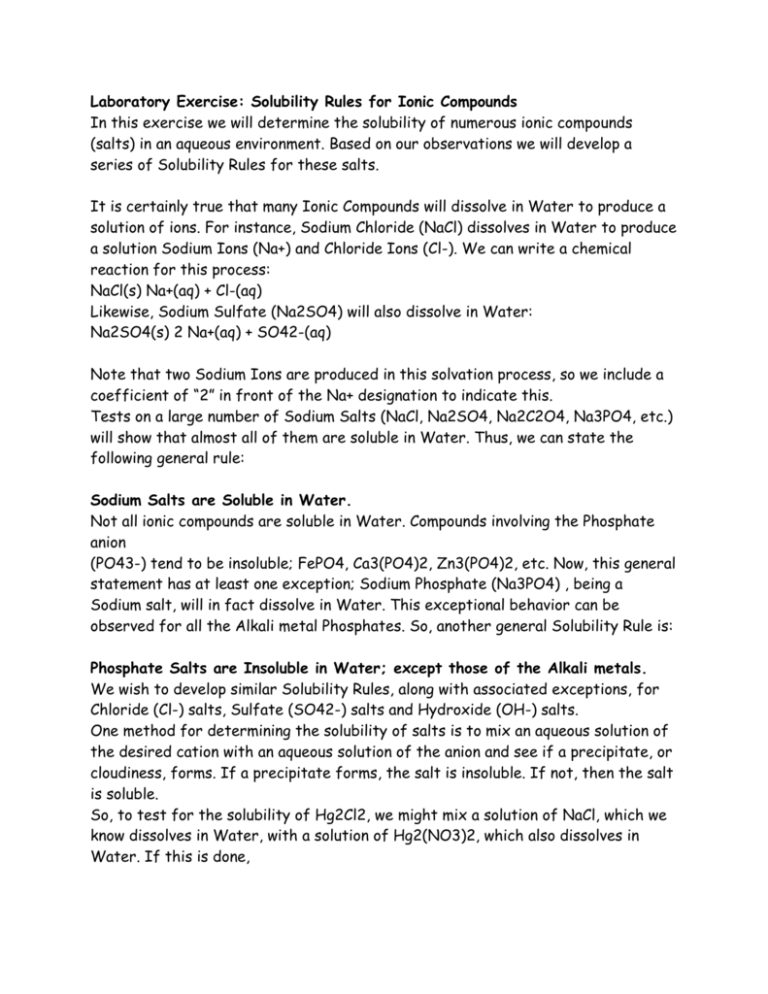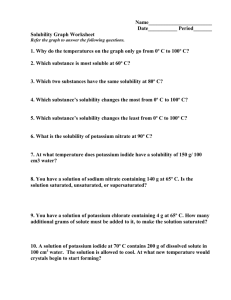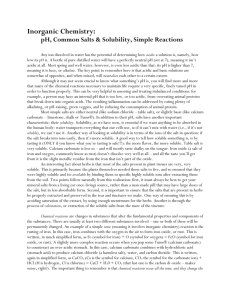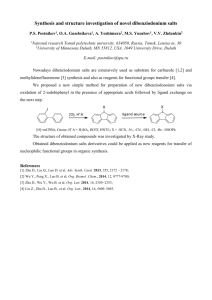Laboratory Exercise: Solubility Rules for Ionic Compounds In this
advertisement

Laboratory Exercise: Solubility Rules for Ionic Compounds In this exercise we will determine the solubility of numerous ionic compounds (salts) in an aqueous environment. Based on our observations we will develop a series of Solubility Rules for these salts. It is certainly true that many Ionic Compounds will dissolve in Water to produce a solution of ions. For instance, Sodium Chloride (NaCl) dissolves in Water to produce a solution Sodium Ions (Na+) and Chloride Ions (Cl-). We can write a chemical reaction for this process: NaCl(s) Na+(aq) + Cl-(aq) Likewise, Sodium Sulfate (Na2SO4) will also dissolve in Water: Na2SO4(s) 2 Na+(aq) + SO42-(aq) Note that two Sodium Ions are produced in this solvation process, so we include a coefficient of “2” in front of the Na+ designation to indicate this. Tests on a large number of Sodium Salts (NaCl, Na2SO4, Na2C2O4, Na3PO4, etc.) will show that almost all of them are soluble in Water. Thus, we can state the following general rule: Sodium Salts are Soluble in Water. Not all ionic compounds are soluble in Water. Compounds involving the Phosphate anion (PO43-) tend to be insoluble; FePO4, Ca3(PO4)2, Zn3(PO4)2, etc. Now, this general statement has at least one exception; Sodium Phosphate (Na3PO4) , being a Sodium salt, will in fact dissolve in Water. This exceptional behavior can be observed for all the Alkali metal Phosphates. So, another general Solubility Rule is: Phosphate Salts are Insoluble in Water; except those of the Alkali metals. We wish to develop similar Solubility Rules, along with associated exceptions, for Chloride (Cl-) salts, Sulfate (SO42-) salts and Hydroxide (OH-) salts. One method for determining the solubility of salts is to mix an aqueous solution of the desired cation with an aqueous solution of the anion and see if a precipitate, or cloudiness, forms. If a precipitate forms, the salt is insoluble. If not, then the salt is soluble. So, to test for the solubility of Hg2Cl2, we might mix a solution of NaCl, which we know dissolves in Water, with a solution of Hg2(NO3)2, which also dissolves in Water. If this is done, we will note that a distinct white solid forms. This indicates Hg2Cl2 is insoluble in Water. We can write this precipitation process as: Hg22+(aq) + 2 Cl-(aq) Hg2Cl2(s) Now you may ask, what about the other cation and anion that are present? Could they also form a precipitate? The answer is yes! However, in this case, the other possible salt would be NaNO3. We have already established that Sodium salts are soluble in Water, so this salt will not precipitate. In this case, the Sodium and Nitrate Ions will simply act as Spectators; they are needed to form the original salt solutions, but they do not participate in the precipitation. We will test the following cations: Na+, Ba2+, Mn2+, Cu2+, Fe3+, Pb2+, Bi3+, Ag+, Ni2+ to see if they form soluble or insoluble salts when mixed with the following anions: NO3-, Cl-, SO42-, OHWe will then form general Solubility Rules for Nitrates, Chlorides, Sulfates and Hydroxides. Procedure Many of our cation mixtures are comprised of heavy metals that are quite toxic. Please take appropriate precautions when handling these solutions. Dispose of all mixtures in the appropriate waste container. Solubility of Nitrate Salts 1. Obtain solutions of the following Nitrate salts: NaNO3, Ba(NO3)2, Mn(NO3)2, Cu(NO3)2, Fe(NO3)3, Pb(NO3)2, Bi(NO3)3, AgNO3, Ni(NO3)2 2. Make observations. Do you note any cloudiness? Solubility of Chloride Salts 1. Place 5 drops of each cation Nitrate into separate small test tubes. 2. To each solution, add 1 drop of 3M HCl. Hydrochloric Acid (HCl) is completely soluble in Water and will act as our source of Chloride Ions (Cl-): HCl(aq) H+(aq) + Cl-(aq) 3. Make observations. Does a precipitate form in any of the solutions? Solubility of Sulfate Salts 1. Dispose of the solutions in the “Cations” water container. 2. Rinse all of your test tubes thoroughly. 3. Again, add 5 drops of each cation Nitrate into the test tubes. 4. To each solution add 1 drop of 1M H2SO4. Sulfuric Acid (H2SO4) is completely soluble in Water and will act as our source of Sulfate Ions (SO42-): H2SO4(aq) 2 H+(aq) + SO42-(aq) 5. Make observations. Does a precipitate form in any of the solutions? Solubility of Hydroxide Salts 1. Dispose of the solutions in the “Cations” water container. 2. Rinse all of your test tubes thoroughly. 3. Again, add 5 drops of each cation Nitrate into the test tubes. 4. To each solution add 1 drop of 1M NaOH. (Careful, it is possible to add too much NaOH.) Sodium Hydroxide (NaOH) is completely soluble in Water and will act as our source of Hydroxide Ions (OH-): NaOH(s) Na+(aq) + OH-(aq) 5. Make observations. Does a precipitate form in any of the solutions? Post Lab Questions: Solubility of Nitrate Salts 1. What is the general rule for the solubility of Nitrate salts? 2. Do you observe any exceptions to this general rule? Solubility of Chloride Salts 1. What is the general rule for the solubility of Chloride salts? 2. Do you observe any exceptions to this general rule? 3. Write precipitation reactions for the above exceptions? (See the Hg2Cl2 example.) Solubility of Sulfate Salts 1. What is the general rule for the solubility of Sulfate salts? 2. Do you observe any exceptions to this general rule? 3. Write precipitation reactions for the above exceptions. Solubility of Hydroxide Salts 1. What is the general rule for the solubility of Hydroxide salts? 2. Do you observe any exceptions to this general rule? 3. Write precipitation reactions for each salt following the general rule.






